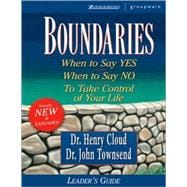
Note: Supplemental materials are not guaranteed with Rental or Used book purchases.
Purchase Benefits
What is included with this book?
| Contents | |
| Preface | |
| Laying the Foundation | |
| Each Boundaries Kit Contains | |
| How This Leader’s Guide Is Organized | |
| A Note About Timing | |
| Five Tips for Leading Group Discussion | |
| Session 1: What Is a Boundary? | |
| Session 2: Understanding Boundaries | |
| Session 3: The Laws of Boundaries, Part I | |
| Session 4: The Laws of Boundaries, Part II | |
| Session 5: Myths About Boundaries | |
| Session 6: Boundary Conflicts, Part I | |
| Session 7: Boundary Conflicts, Part II | |
| Session 8: Boundary Successes, Part I |
The New copy of this book will include any supplemental materials advertised. Please check the title of the book to determine if it should include any access cards, study guides, lab manuals, CDs, etc.
The Used, Rental and eBook copies of this book are not guaranteed to include any supplemental materials. Typically, only the book itself is included. This is true even if the title states it includes any access cards, study guides, lab manuals, CDs, etc.
Excerpted from Boundaries: When to Say Yes, When to Say No to Take Control of Your Life by Henry Cloud, John Townsend
All rights reserved by the original copyright owners. Excerpts are provided for display purposes only and may not be reproduced, reprinted or distributed without the written permission of the publisher.